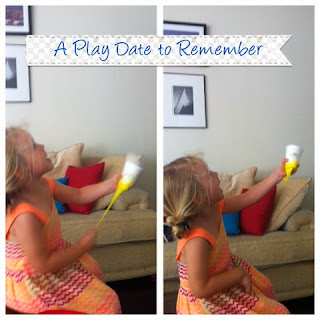With the World Cup in full swing, we have been practicing our football skills (or soccer depending on which side of the Atlantic you live on)
Football is not just a great activity to develop physical skills such as kicking and foot-eye coordination but social skills and spacial awareness, to name but a few.
With two pool noodles, four chop sticks and a football, you can create your own mini football match.
Who knew there would be so much fun to be had with pool noodles! For other fun ideas of how to use your 'noodle' check out the following sites:
- www.parents.com for how to make obstacle courses and other backyard games. They even feature a football obsicle course, that gave me the idea for the activity.
- www.bathactivitiesforkids.com have some really fun games for noodle play in the bath.
Who can play?
If your child is able to stand up, they can start practicing kicking or rolling a ball.
Safety:
Be careful with the chop sticks and ensure that the noodles are completely over them. If a child falls on them, they could poke them in the eye etc.
What did the Critique have to say?
"I think it's funny when my shoe flies off, when I kick the ball... I like passing the ball, it's tricky" Bee aged 3 years old.
What do you need?
- Four chopsticks
- Two pool noodles
- One football
What did we do?
To make the football goal posts, first we had to push two chopsticks half way into the ground
 |
| Chopsticks placed into the ground |
 |
| Place a pool noodle onto the chopsticks |
We had a great time playing football. We talked about how in football we use our feet instead of our hands, learnt how to stop the ball with our feet and pass it to one and other. Bee also really enjoyed just practicing trying to kick it through the posts. We developed our social skills too as we took it in turns being a goal keeper and cooperated.
Have fun and may the best team win :-)
 |
| The finished product |
What did we learn?
- Communication, language and listening- listening to instructions, developing language by learning new words, such as dribbling, passing and scoring.
- Mathematical- counting goals scored. Developing Spacial awareness and directional language , such as pass it to the left/right.
- Knowledge and understanding- playing in the outdoor environment. As it is World Cup season, you could also talk about the different countries that are participating
- Personal, social and emotional- Fun and enjoyment. Taking turns and cooperating. Being involved in the same theme as someone else. Pride in learning a new skill or scoring a goal.
- Expressive arts and design- creating the arch with pool noodles. You could also experiment with making other shaped/sculptures with the pool noodles and chopsticks (depending on the child's age and stage of development)
- Physical- developing leg muscles. Passing the ball and aiming it into the goal. Running and stopping the ball with their feet.
What could be done next?
- For older children add two yellow pieces of card, one red piece of card and a whistle. This will develop awareness of the rules of football and role play
- Try some of the another activities using pool noodles, as mentioned above.
- Invite friends over for a football match.
- As it is World Cup season, encorpate art and design, knowledge and understanding and literacy skills by making your own posters or flags of the world.































